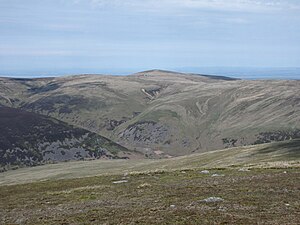High Pike (Caldbeck): Difference between revisions
Created page with "{{Infobox hill |name=High Pike |county=Cumberland |range=Lake District Northern Fells |picture=High_Pike_from_Bowscale_Fell.jpg |picture caption=High Pike from Bowscale Fell |..." |
No edit summary |
||
| Line 2: | Line 2: | ||
|name=High Pike | |name=High Pike | ||
|county=Cumberland | |county=Cumberland | ||
|range= | |range=Calbeck Fells | ||
|picture=High_Pike_from_Bowscale_Fell.jpg | |picture=High_Pike_from_Bowscale_Fell.jpg | ||
|picture caption=High Pike from Bowscale Fell | |picture caption=High Pike from Bowscale Fell | ||
Revision as of 12:28, 27 June 2017
| High Pike | |||
| Cumberland | |||
|---|---|---|---|
 High Pike from Bowscale Fell | |||
| Range: | Calbeck Fells | ||
| Summit: | 2,159 feet NY318350 54°42’18"N, 3°3’36"W | ||
High Pike is a fell in Cumberland, in the Lake District's Northern Fells, three miles south of Caldbeck. It reaches a height of 2,159 feet and is the most northerly of the Lakeland fells over 2,000 feet.
High Pike is a large fell with its northern slopes falling away towards the lower ground between Caldbeck and Carlisle. Like the neighbouring Carrock Fell it has been extensively mined and the wealth created by the abundant variety of minerals on High Pike led to the saying "Caldbeck fells are worth all England else".
Another fell of the same name is to be found in Westmorland: High Pike in Scandale near Ambleside.
Landscape

High Pike’s position on the northern perimeter of the Lake District gives a fine view of the Solway Firth and the Galloway Hills to the north. However the view south is severely curtailed by the bulks of Skiddaw and Blencathra and the main body of Lakeland is not seen well.
High Pike has two subsidiary tops which are also classed as 'Nuttall' fells:
These are to the south-west of the main summit, 700 yards and a thousand yards from it respectively.
Summit
High Pike’s summit is of some interest, it is used as a beacon by the population of Caldbeck and a fire is lit to celebrate important events such as the Millennium and coronations.
The summit also has a massive cairn which was originally a shepherd's cottage and has become a ruin. There is a trig point which has been mounted with a plaque which says “To Celebrate Caldbeck Parish’s Millennium Celebrations”, there is also a substantial wind shelter nearby which has also been built from the stones from the ruined cottage. There is even a slate bench on the summit, bearing a poignant memorial plaque.
The mountaineer Chris Bonington lives in nearby Caldbeck and is he is often to be seen walking his dog on High Pike, he told a local newspaper in May 2005:
- “This [High Pike] is a hill I feel truly at home on, It has always been one I can return to after climbing some serious peak in the Himalaya or Alps and return to earth. It has the most wonderful changing moods. The light is ever-shifting across the fell making a kaleidoscope of colours, and its wildlife is fascinating.”
Mining
The mines of High Pike, which all lie on its northern slopes, have yielded numerous minerals since the 16th century, in fact, the most famous, Roughtongill is reputed to have yielded 23 different ores. Copper was extracted at the Sandbeds mine while lead and copper was mined at Driggeth mine. Latter some of the mines were reopened during the Second World War for the extraction of Barium sulfate|barytes which was needed for the production of munitions. The last mine closed in 1966.
Ascents
A direct ascent of High Pike is usually done from the north, starting around the Caldbeck area, however the fell is often climbed in conjunction with the nearby fells of Carrock Fell, Knott and Great Calva making a circular walk that starts and finishes near Mosedale to the south of Carrock Fell.
References
- Wainwright, Alfred: A Pictorial Guide to the Lakeland Fells, Book Five — The Northern Fells (1962)
- Bill Birkett: Complete Lakeland Fells, ISBN 0-00-713629-3
- The Mountains of England and Wales, John and Anne Nuttall ISBN 1-85284-037-4
- Chris Bonnington - ‘High Pike is the hill I feel really at home on’